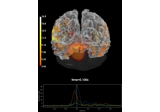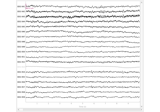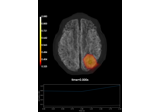mne.setup_volume_source_space#
- mne.setup_volume_source_space(subject=None, pos=5.0, mri=None, sphere=None, bem=None, surface=None, mindist=5.0, exclude=0.0, subjects_dir=None, volume_label=None, add_interpolator=True, sphere_units='m', single_volume=False, verbose=None)[source]#
Set up a volume source space with grid spacing or discrete source space.
- Parameters
- subject
str|None Subject to process. If None, the path to the MRI volume must be absolute to get a volume source space. If a subject name is provided the T1.mgz file will be found automatically. Defaults to None.
- pos
float|dict Positions to use for sources. If float, a grid will be constructed with the spacing given by
posin mm, generating a volume source space. If dict, pos[‘rr’] and pos[‘nn’] will be used as the source space locations (in meters) and normals, respectively, creating a discrete source space.Note
For a discrete source space (
posis a dict),mrimust be None.- mri
str|None The filename of an MRI volume (mgh or mgz) to create the interpolation matrix over. Source estimates obtained in the volume source space can then be morphed onto the MRI volume using this interpolator. If pos is a dict, this cannot be None. If subject name is provided,
posis a float orvolume_labelare not provided then themriparameter will default to ‘T1.mgz’ oraseg.mgz, respectively, else it will stay None.- sphere
ndarray, shape (4,) |ConductorModel|None Define spherical source space bounds using origin and radius given by (ox, oy, oz, rad) in
sphere_units. Only used ifbemandsurfaceare both None. Can also be a spherical ConductorModel, which will use the origin and radius. None (the default) uses a head-digitization fit.- bempath-like |
None|ConductorModel Define source space bounds using a BEM file (specifically the inner skull surface) or a ConductorModel for a 1-layer of 3-layers BEM.
- surfacepath-like |
dict|None Define source space bounds using a FreeSurfer surface file. Can also be a dictionary with entries
'rr'and'tris', such as those returned bymne.read_surface().- mindist
float Exclude points closer than this distance (mm) to the bounding surface.
- exclude
float Exclude points closer than this distance (mm) from the center of mass of the bounding surface.
- subjects_dirpath-like |
None The path to the directory containing the FreeSurfer subjects reconstructions. If
None, defaults to theSUBJECTS_DIRenvironment variable.- volume_label
str|dict|list|None Region(s) of interest to use. None (default) will create a single whole-brain source space. Otherwise, a separate source space will be created for each entry in the list or dict (str will be turned into a single-element list). If list of str, standard Freesurfer labels are assumed. If dict, should be a mapping of region names to atlas id numbers, allowing the use of other atlases.
Changed in version 0.21.0: Support for dict added.
- add_interpolator
bool If True and
mriis not None, then an interpolation matrix will be produced.- sphere_units
str Defaults to
"m".New in v0.20.
- single_volume
bool If True, multiple values of
volume_labelwill be merged into a a single source space instead of occupying multiple source spaces (one for each sub-volume), i.e.,len(src)will be1instead oflen(volume_label). This can help conserve memory and disk space when many labels are used.New in v0.21.
- verbose
bool|str|int|None Control verbosity of the logging output. If
None, use the default verbosity level. See the logging documentation andmne.verbose()for details. Should only be passed as a keyword argument.
- subject
- Returns
- src
SourceSpaces A
SourceSpacesobject containing one source space for each entry ofvolume_labels, or a single source space ifvolume_labelswas not specified.
- src
See also
Notes
Volume source spaces are related to an MRI image such as T1 and allow to visualize source estimates overlaid on MRIs and to morph estimates to a template brain for group analysis. Discrete source spaces don’t allow this. If you provide a subject name the T1 MRI will be used by default.
When you work with a source space formed from a grid you need to specify the domain in which the grid will be defined. There are three ways of specifying this: (i) sphere, (ii) bem model, and (iii) surface. The default behavior is to use sphere model (
sphere=(0.0, 0.0, 0.0, 90.0)) ifbemorsurfaceis notNonethensphereis ignored. If you’re going to use a BEM conductor model for forward model it is recommended to pass it here.To create a discrete source space,
posmust be a dict,mrimust be None, andvolume_labelmust be None. To create a whole brain volume source space,posmust be a float and ‘mri’ must be provided.To create a volume source space from label,
posmust be a float,volume_labelmust be provided, and ‘mri’ must refer to a .mgh or .mgz file with values corresponding to the freesurfer lookup-table (typicallyaseg.mgz).
Examples using mne.setup_volume_source_space#

Compute MNE inverse solution on evoked data with a mixed source space




